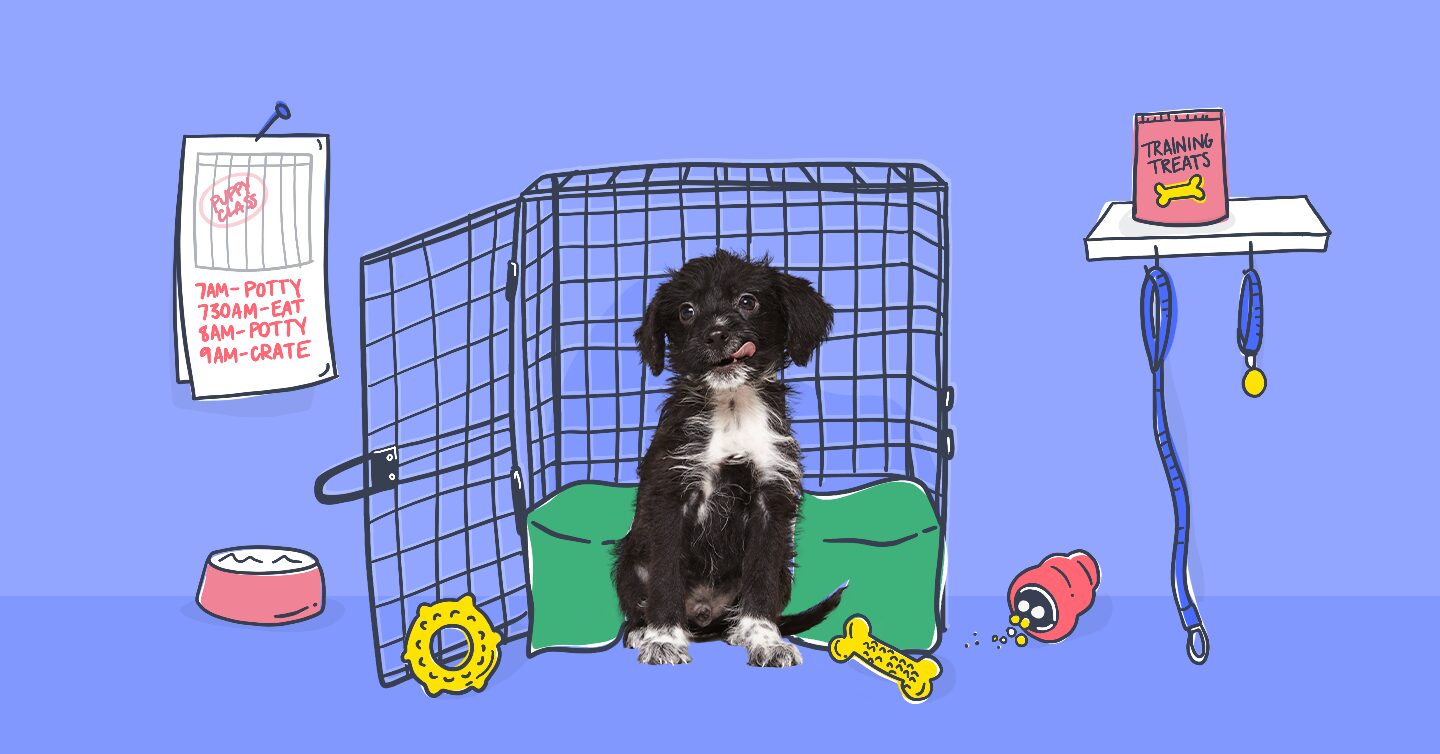So you’ve added a new four-legged family member to your house – congratulations! While puppyhood comes with lots of fun, love, and firsts, it’s also the most crucial time in your new dog’s development.
Since raising a puppy isn’t an easy task, we’ve consulted some professional dog trainers for useful tips on how to welcome a new puppy into your home – and how to start dog training. So wrangle up your furbaby, grab some treats, and teach your new puppy how to be the goodest doggo in the pack!
Training tips from Richard Lovejoy
1. Make sure everyone in the house is on the same page
Before you bring your new puppy into your home, speak with everyone in your house about dividing responsibilities and training your puppy. It’s hard for a dog to deal with multiple teachers who all have different rules – how will they know what’s right and what’s wrong? Everyone needs to be on the same page about what the dog’s boundaries are, and everyone needs to adhere consistently to those boundaries. Also, it’s crucial that everyone has a hand in taking care of and training the dog – that way, the dog won’t be hyper-attached to one person. Making sure everyone is involved also prevents the dog from becoming territorial over a single person, helping them be happier and more social in the long run.
2. Reward good behavior, ignore bad behavior
As a general rule of thumb, dog owners should use positive reinforcement when a puppy behaves well and use negative reinforcement – i.e., ignoring them – when they misbehave. Keep in mind that rewards can take many forms, from treats to petting to toys to compliments to simply giving them more attention. Whenever a dog obeys a command, praise them! On the flip side, when a dog does something you don’t want them to, ignore them. This can be something as simple as turning your back or calmly exiting the room. Your dog will soon learn that the behavior they exhibited results in nothing and gets them nowhere. When the dog calms down, return to normal activity.
3. Teach bite inhibition
It’s important to teach your puppy bite inhibition – also known as having a soft mouth – early on in their development. Dogs have a natural instinct to bite, and whether they mean to hurt you or not, they’re driven to do things like chomp on your fingers when you’re trying to give them a treat! Frequently hand-feed your puppy kibble so they learn to gently take food from your hands. Make sure to interact with your puppy in this way consistently to reinforce their bite inhibition, and don’t stop practicing until they nail it down.
Pet Pro Tip: New kitten owners often underestimate the long-term costs of veterinary care for a pet’s unexpected accidents & illnesses. Make sure you get your kitten insured as soon as possible!
4. Use Kongs as a primary method of feeding
Not only are Kongs a great way to feed your puppy – they’re also great chew toys and mind games, which means they give your pup some much-needed mental stimulation. Feeding your puppy with a Kong will also help them develop healthy eating habits and show that you’re in charge of their food supply. Sometimes, puppies get in the habit of guarding their food, leading them to nibble throughout the day rather than eating it all at once. But if you feed them with a Kong and take it away after a period of time, your dog will learn to eat at the moment their food is put in front of them. Kongs come in a few different shapes and sizes, and these puppy teething natural rubber Kongs are perfect for your little friend.
Training Tips from Bark Busters
5. Establish a schedule
Creating a solid schedule will help your puppy adjust to their new life with you, lessening their anxiety and making them feel comfortable and safe. Set up a feeding schedule and a potty schedule so your puppy always knows what to expect – and, most importantly, make sure everyone in the house follows them. Occasional deviations are okay, but so long as you try your best to be consistent, your puppy will adjust in no time!
6. Start crate training right away
Crates are natural dens that help your puppy feel safe – once they get used to it. Purchase a crate that’s the appropriate size for your dog and have it ready the day you bring your new pal home. Make sure its door is always open, and let your new puppy explore it on their own so they can learn to trust it.
7. Use your scent to ease their anxiety
Leaving your new puppy at home alone can be very traumatic for them. But the fact is, you can’t be home all the time. Place an item of your clothing or a blanket with your scent on it inside their crate with them before you leave the house. This will help your puppy calm down and prevent them from developing separation anxiety.
8. Put your puppy in training classes early
Puppy classes are essential. Beyond reinforcing the basic commands you’re teaching your puppy at home, classes are also a great way to socialize them. Be sure your pup has all their required vaccinations before they take part in these training sessions. Once you begin your classes, you’ll be around other dog owners who are all in the same boat as you. Maybe you and your classmates can learn something from each other!
Now that we’ve covered some of the basics of bringing your puppy home and getting started with their training, let’s dive into three topics that might be the most concerning to fur-parents: chewing, potty training, and sleeping. The qualified folks at Bark Busters have lots of experience in this realm, so they’ve shared their expertise in getting your dog to use the bathroom where they should, chew on what they should, and sleep when they should!
Tips for chewing
Chewing is a natural function of your dog’s development. It provides a form of stress relief, which helps with separation anxiety and preventing destructive behavior – but only if it’s managed properly. Bark Busters recommends using chew toys that are the appropriate size for your dog, giving your pup chew toys when they’re in their den area to create positive associations, and giving your pup chew toys before bed to help them fall asleep. It’s also important not to go overboard with the toys and dog treats when you first get a puppy. If your dog has too many chew toys, they can have trouble figuring out what they can and can’t chew on, so just buy them a few toys.
Tips for sleeping
Having a puppy is like having a newborn baby. And as any parent knows, sleep can be an issue. Puppies need an average of 18 to 20 hours of sleep in a given 24-hour period while they’re young. In the beginning, they’ll cry during the night, so check on them to make sure they aren’t hurt or stuck in their crate. Talk to them in a normal voice, as using a high-pitched or soft voice can reinforce their tendency to cry at night. Have your dog sleep in a crate in the beginning, and keep it in an area near the family so your puppy won’t feel ostracized. However, don’t place the crate in your bedroom – this can increase separation anxiety.
Tips for potty training
The most important thing to remember about potty training is that it takes a lot of time and patience. Be prepared to fully invest in this process. Bark Busters offers the following guideline: puppies can hold their bladders for the number of hours equal to their age in months plus one. (For instance, a two-month-old puppy can last three hours.) So when it’s time for your puppy to go, follow these rules.
Confine your puppy to a small room or area when they’re first learning. Close doors or use baby gates to designate this area where they’re going to learn to go potty initially.
- Take your puppy out at regular intervals. Try to stick to an established bathroom schedule. According to Bark Busters, there are six critical times your puppy should be going potty: after waking up, before going to bed for the night, after eating or drinking, after or during an exuberant playtime, when they’re frightened or nervous, and after people arrive at their home.
- Stay in the potty area with your puppy as they’re going to the bathroom. Praise them while they’re doing it.
- Don’t punish your puppy for accidents! Doing so can increase their anxiety around going to the bathroom in general. They likely won’t understand what they’re being punished for, and they might start finding hiding spots to go potty in out of fear of being punished by you. The best thing you can do is clean up the mess and catch your puppy sooner the next time.
- If you catch your puppy right before or while they’re going potty somewhere they shouldn’t, take them to the designated potty area as quickly as you can. Praise your puppy while they go potty in this area.
Training a puppy requires a lot of time, effort, and patience. It’s important to remember that your new puppy is a lot of responsibility. If you stay consistent with your training – and follow these rules – your puppy will become the furbulous four-legged companion you know they’re capable of being! For more tips, facts, and information about all things dogs, check out the Pumpkin blog.




